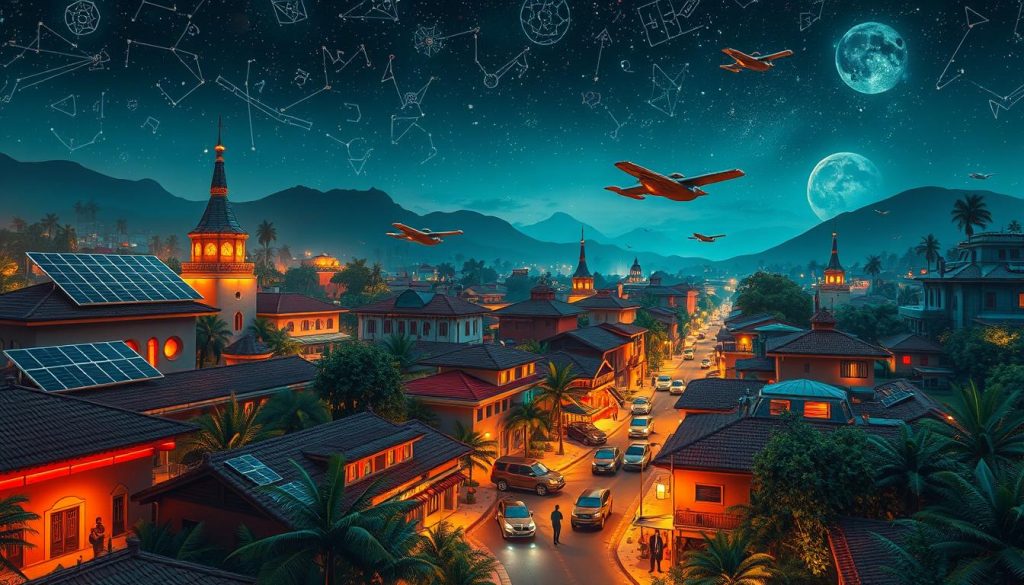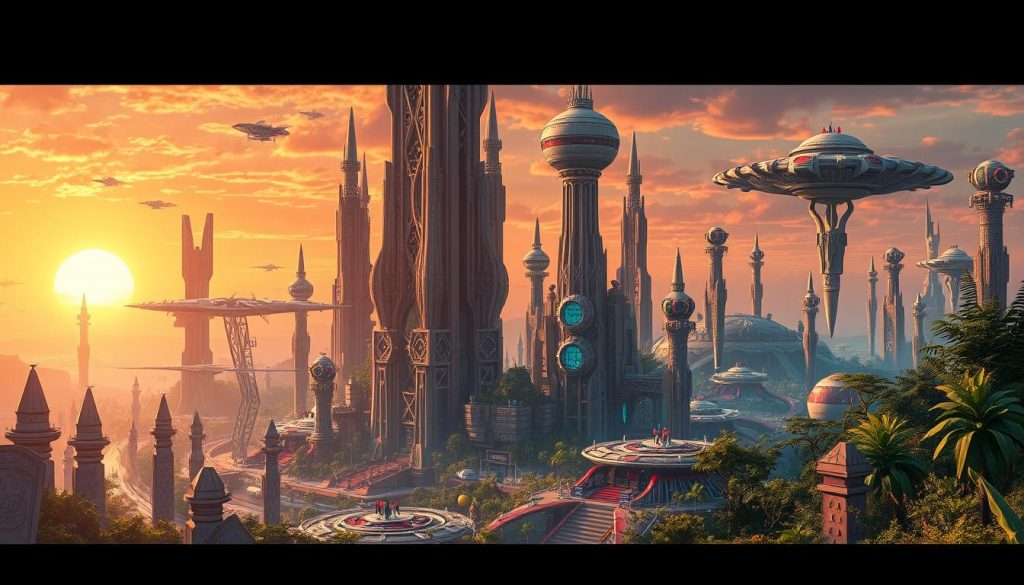Afrofuturism: A Cultural Movement in Art and Music
Afrofuturism is a cultural movement that combines art, music, and technology. It reimagines the African diaspora’s stories. This movement looks at African culture through a futuristic lens, blending past and future.
Anúncios
The term Afrofuturism was coined in the 1990s. It merges science fiction with cultural expressions. Today, it’s key in talks about identity and representation in art and music.
Afrofuturism showcases African culture’s achievements and tackles today’s social and political issues. This article will explore Afrofuturism’s roots, its connection to technology, and influential figures in music and visual arts.
What is Afrofuturism?
Afrofuturism is a mix of African culture, technology, and science fiction. It’s about empowering Black identities through stories of the future. These stories challenge old stereotypes and show new paths for Africa.
This movement lets the African diaspora celebrate their heritage and dream of the future. It combines mysticism, science fiction, and nostalgia. This creates a rich tapestry that honors black culture and innovation.
Anúncios
Afrofuturism is more than just a movement; it’s a powerful critique and vision for the future. It imagines societies that respect African traditions. This inspires talks about fairness and equality for all.
The Roots of Afrofuturism
Afrofuturism comes from the African diaspora’s history. It mixes African spirituality, the slave trade, and the civil rights movement. These elements form its core.
Artists like Sun Ra and Octavia Butler are key. They merged African culture with science fiction. Their work shows how creativity can change our views of the future.
The Harlem Renaissance of the 1920s and 1930s was a turning point. It celebrated black culture and pushed for recognition in literature and arts. This laid the groundwork for future generations to see a future shaped by African heritage.
Today, Afrofuturism is seen in art, music, and literature. It connects the past to the present, exploring identity and power. It empowers the African American community in many ways.
To learn more about Afrofuturism’s roots, check out this resource on its history and growth.
The Intersection of Art and Technology
Afrofuturism and technology are changing art in big ways. Artists use new tools to tell stories and show their work in new ways. Digital art lets them explore virtual worlds and mix media, showing African stories and futures.
Artists like Jesse Jumanji and Ytasha Womack lead this change. They use digital tools to show how African culture can be seen online. This mix of old and new art makes us think about identity, how we’re seen, and our cultural past.
The table below shows how art and tech come together in Afrofuturism:
| Art Form | Technological Influence | Key Artist(s) |
|---|---|---|
| Digital Painting | Use of software and tools for creation | Ytasha Womack |
| Virtual Reality Installations | Immersive environments and experiences | Jesse Jumanji |
| Augmented Reality | Overlaying digital elements onto real-world settings | Unknown Innovators |
| Mixed Media | Combining traditional and digital techniques | Various Artists |
This new art makes us think differently about black stories in tech. Afrofuturism keeps growing, and tech is key to its identity. By exploring cultural heritage with new tech, we open up new possibilities. It makes sure that everyone’s voice is heard in our future.

Key Figures in Afrofuturism
Many Afrofuturism artists have shaped this movement. They work in music, literature, and visual arts. Their work shows a mix of creativity and cultural exchange.
Sun Ra is a key figure in music. He used jazz to explore space, identity, and innovation. His unique sound and performances have inspired many.
Octavia Butler is a pioneer in literature. Her science fiction novels address race, gender, and society. She’s a leading notable creator in Afrofuturism, encouraging a diverse future.
Visual artists like Wangechi Mutu and Safia Elhillo also play a big role. They mix African identity with futuristic ideas. Their work makes us think about culture and identity.
New voices like Nnedi Okorafor are also making waves. They bring fresh ideas to Afrofuturism. Their work talks about global themes and cultural exchange.
| Name | Field | Notable Contribution |
|---|---|---|
| Sun Ra | Music | Innovative jazz exploring space and identity |
| Octavia Butler | Literature | Pioneering explorations of race and gender in science fiction |
| Wangechi Mutu | Visual Arts | Integrating African identity and futuristic themes |
| Safia Elhillo | Visual Arts | Exploring ancestral connections through art |
| Nnedi Okorafor | Literature | Modern interpretations and intercultural dialogues |
Afrofuturism in Music
Afrofuturism is changing the music world, influencing genres like jazz, hip-hop, and electronic music. It lets artists express black identity through futuristic sounds and new ideas. Erykah Badu and Janelle Monáe are key figures in this movement, showing how Afrofuturism shapes music.
Erykah Badu mixes spirituality and cosmic themes in her music, taking listeners on a journey. She combines traditional African rhythms with modern beats, telling unique cultural stories. Janelle Monáe tackles big issues and paints a picture of the future, showing Afrofuturism’s depth.
Artists like Flying Lotus are pushing music forward, mixing hip-hop with electronic sounds. This mix makes listeners think about new worlds beyond what we know. Afrofuturism’s influence on music creates a diverse and engaging sound for fans everywhere.
Afrofuturism in Visual Arts
Visual arts in Afrofuturism cover many styles and mediums. They give Afrofuturist artists a chance to show black identities and futures. Artists like Wangechi Mutu and Kehinde Wiley lead this movement. They make artworks that make us think and question old stories about race and culture.
Kehinde Wiley’s portraits mix history with today’s world. His colorful and bold works make us see identity in a new light. On the other hand, Wangechi Mutu uses collage, painting, and assemblage. She tells stories that mix myths with social comments, showing African heritage and futures.
Their art is full of life, sparking conversations about African heritage. Shows like “The Shadows Took Shape” show how art reimagines history. These events highlight how Afrofuturist artists fight for a world where everyone’s identity is respected.
| Artist | Artistic Medium | Themes |
|---|---|---|
| Kehinde Wiley | Painting | Identity, Race, Historical Figures |
| Wangechi Mutu | Collage/Painting | Mythology, Culture, Gender |
| Simone Leigh | Sculpture | Black Womanhood, History |
| Yinka Shonibare | Mixed Media | Colonialism, Identity |
The impact of Afrofuturism in visual arts is growing. It makes us think about the future of black culture and identity. It opens doors for new artists to come.
The Sociopolitical Impact of Afrofuturism
Afrofuturism looks at big issues in society and gives a voice to many. It talks about social justice and race, making us think about our world. It helps us see the struggles of others and understand their stories.
Art in Afrofuturism talks about racism and identity. It shows a world where black people are not just seen but also valued. It’s about breaking free from old ways and creating a better future.
Here’s a table showing what Afrofuturism talks about and how it affects us:
| Sociopolitical Theme | Description | Societal Implication |
|---|---|---|
| Equity and Representation | It’s about making sure everyone’s story is told in media and art. | It makes our culture more welcoming and fights against being forgotten. |
| Historical Reflection | It looks back at the history of African diaspora communities. | It helps us understand who we are and teaches future generations. |
| Empowerment | It dreams of a future where black people are leaders and succeed. | It motivates communities to tell their own stories and dream big. |
| Challenging Norms | It uses art to question and change how we act and think. | It makes us think deeply and get involved in making a difference. |
Afrofuturism in Literature
Afrofuturist literature is a genre that mixes science fiction, fantasy, and African history. It features writers who have opened up new paths in Afrofuturism. Nnedi Okorafor and Octavia Butler are among them, exploring themes like race, identity, and culture and technology.
Nnedi Okorafor weaves African folklore into her stories, making them both fun and educational. Octavia Butler, on the other hand, tackles tough social issues with a speculative twist. Anthologies like “Afrofuturism: Science Fiction and the African Diaspora” showcase a variety of African diaspora voices.
Afrofuturist literature is key in showing the diversity of Black experiences in science fiction. It encourages readers to imagine worlds that celebrate African culture’s depth and complexity.
Future Trends in Afrofuturism
The future of Afrofuturism looks bright. Artists, musicians, and writers are pushing the boundaries of cultural expressions. This is happening as more diverse stories become accepted in mainstream culture.
New technologies like virtual reality and artificial intelligence are changing how we tell stories. These tools let creators show their visions in new ways. Artists are using them to create immersive experiences that mix stories with futuristic themes.

Working together across different fields will also make Afrofuturism richer. Joint projects can bring together art, technology, and culture. This will expand the movement’s reach and impact.
- Focus on social justice and equity will stay key, using Afrofuturism to talk about race and identity.
- New platforms for storytelling will encourage a new generation to dream of diverse futures.
- Innovative works might show a more inclusive society, pushing what Afrofuturism can be.
This vibrant movement keeps inspiring creators to dream big. Future cultural innovations in Afrofuturism will likely keep engaging audiences. They will share a story that’s complex and rich.
Conclusion
Afrofuturism is a strong cultural movement. It mixes art, music, and literature with technology and history. It tells new stories that celebrate the African diaspora’s complexity.
This movement empowers artists and audiences. It lets them dream of futures that honor their heritage and hopes. Afrofuturism is all about creativity and identity.
Afrofuturism is still growing in our world today. It highlights the importance of seeing ourselves in stories and innovation. It changes how we think about art and society.
It brings up big ideas about who we are and our communities. Afrofuturism shows us how imagination can change things. It’s about progress and being open to everyone.
The journey of Afrofuturism is about discovery and action. It makes sure the African diaspora’s voices are heard and lead. It shapes our culture for the future.
Looking forward, Afrofuturism will keep inspiring new ideas. It shows its key role in today’s art and talks. It’s a bright future for creativity and understanding.
